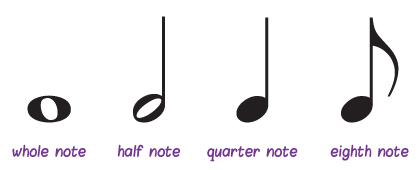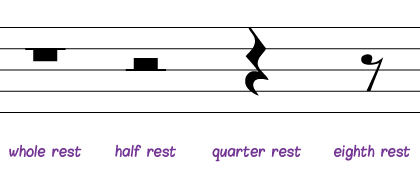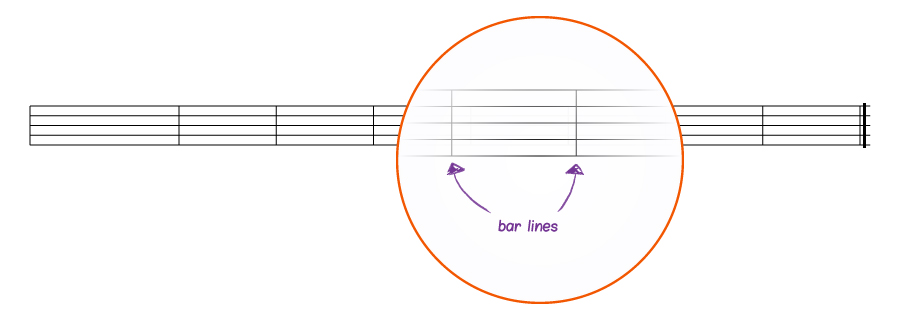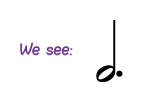Rhythm is the basis of music similar to the way numbers are the basis of math. Rhythm is the “heartbeat” of everything in nature as well as in music. When you play pitches of various lengths, or even repeat the same pitch on an instrument, you create something called rhythm. Over the years, written notations were developed to record music. Rhythm is shown by writing notes and rests of different lengths.
Notes
Different symbols, called notes, are used to tell how long a sound should last. The simplest-looking note, with no stems or flags, is a whole note. All other note lengths are defined by how long they last compared to a whole note. A note that lasts half as long as a whole note is called a half note.
A note that lasts a quarter as long as a whole note is called a quarter note.
In the same way, we can have eighth notes, sixteenth notes, and thirty-second notes.
Here are some common note lengths:

Rests
Different symbols, called rests, designate different periods of silence. The simplest-looking rest is a whole rest. All other rest lengths are defined by how long they last compared to a whole rest.
A rest that lasts half as long as a whole rest is called a half rest.
A rest that lasts a quarter as long as a whole rest is called a quarter rest.
In the same way, we can have eighth rests, sixteenth rests, and thirty-second rests.
Here are some common rests:

Measures
Music is the organization of sounds in time. The specific placement of the sounds in time defines the RHYTHM of a piece of music. Since rhythm measures time, words such as measures and time signatures are used to help define rhythm for different pieces of music.
A measure is the space between two bar lines on the staff.

A piece of music is divided into measures for several reasons. Each measure aids the eye in reading music, much like punctuation does in written language. Also a measure line (like punctuation) helps define the relative stresses each note receives (like syllables in spoken and written language). Each measure with a given time signature represents the same amount of time in a given piece of music.
Beats
Much as measures split the music into portions, each measure is then mentally split into equal sub-portions called beats. (Beat may be thought of as the steady pulse in music).
The first beat in a measure is referred to as the downbeat. This often sets up a pattern in the beats.
The example below shows a common pattern:
One – two – three, One – two – three
In such a three-beat pattern, this is written in musical notation as:

One – two, One – two would be written in musical notation as:

The speed of the beats determines the tempo (or speed) of the music.
A time signature is found at the beginning of a musical selection following the key signature. It looks like a fraction without a dividing bar. Time signatures contain two numbers. The top number tells you how many beats there are in a measure. The bottom number tells you what kind of note (half, quarter, eighth, etc…) gets a beat.

This means that a half note
![]()
would receive two beats.
A whole note
![]()
would receive 4 beats.
Eighth notes
![]()
play for only a half of a beat and are often seen combined or beamed together.
A dot that follows a note has a special rule. The dot receives half the value of the note to which it is attached. What if you see a dot after a half note? The calculation works as follows:

![]() half note counts for two quarter beats. We then add the value of the •, (half of 2 is 1), for a total of 3 beats.
half note counts for two quarter beats. We then add the value of the •, (half of 2 is 1), for a total of 3 beats.
A ![]() measure may be filled with any combination of notes that equals the value of four quarter notes.
measure may be filled with any combination of notes that equals the value of four quarter notes.
Special Section: Music to Math Comparison
A time signature is found at the beginning of a musical section next to the key signature. It looks like a fraction without a dividing bar. There is a reason that time signatures do not have a “bar” (which divides an arithmetical fraction into “numerator” and “denominator”).
Even though time signatures behave very much like fractions, in that a
![]()
denotes “three quarters”, (the “quarter” in this case is a quarter “note”), arithmetical fractions are an expression of proportion relative to the number 1, or unity. That is, in arithmetic, ¾ is “three quarters of one, or 75% of one.
Musical
![]()
time is subtly different in that the reference “unity” is not the number 1, but is, rather, defined by the bottom number. That is, in
![]()
time, the quarter note (bottom number) is defined as the basic counting unit, with the top number (in this case, 3) meaning that there are three of these units per measure.
Music thus elevates the quarter note to the status of being the basic counting unit.
In monetary terms, this might be similar to announcing that, henceforth, all prices of goods would be expressed as if the quarter (25 cents) were the counting unit. This would mean that something that costs $1.25 under our present system would be expressed as costing Q5 (where “Q” is the value of a quarter) in the new system.
Understanding this helps us comprehend why music can have signatures such as
![]()
time signature. This is not the same as in mathematics, where 5/4 = 1.25, but sets up a basis in music very much like the example above, where 25 cents became the basic unit.
![]()
musical time is a specific musical object. It tells us that the quarter note is the basic unit and that each measure will contain five of these units.
